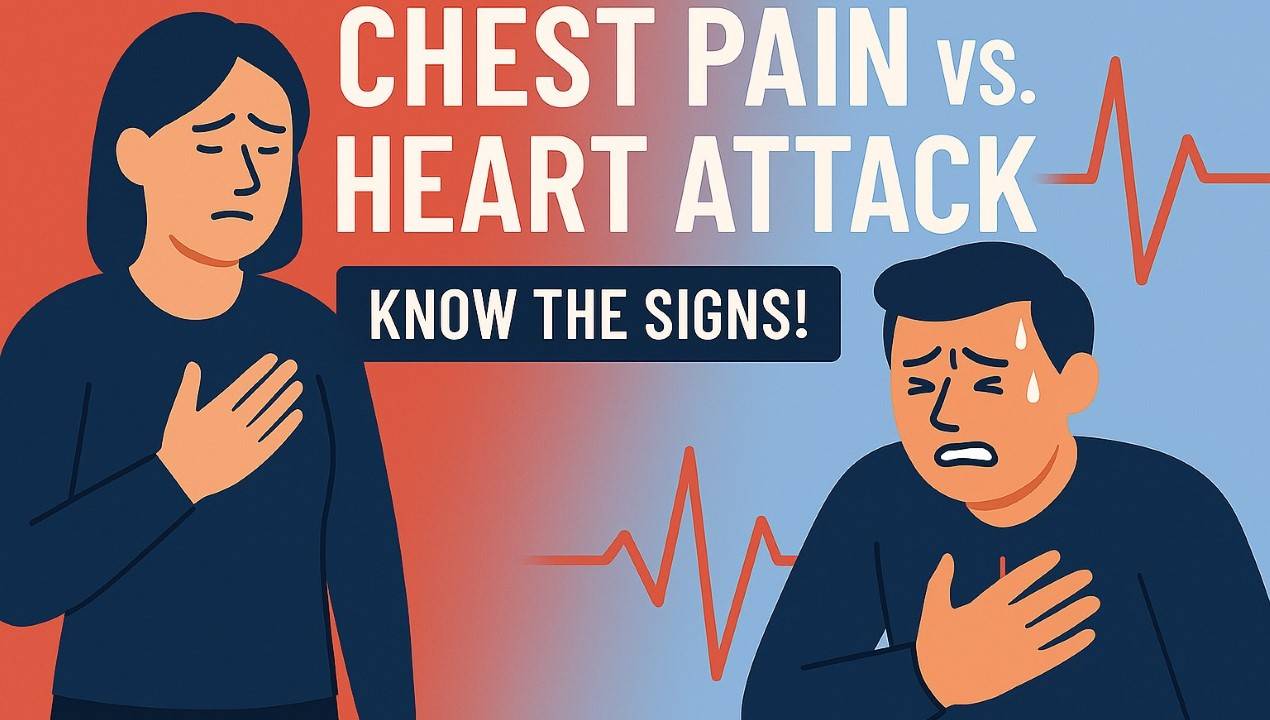Chest Pain vs. Heart Attack can be confusing and scary. You feel a tight or sharp pain in your chest, and you wonder, Is this serious? Not all chest pain means a heart attack, but knowing the difference can save your life. The fix? Learn the signs, stay calm, and call for help if the pain feels intense or lasts long. In this guide, we’ll explain the Difference between chest pain and heart attack symptoms in simple words to help you understand and act fast.
Why Chest Pain vs. Heart Attack Matters
Chest pain is common, but it doesn’t always mean a heart attack. I’ve seen friends panic over chest discomfort, thinking it’s a heart attack, only to learn it was something less serious, like heartburn. Understanding Chest Pain vs. Heart Attack helps you stay calm and make smart choices. This guide will break down the difference between chest pain and heart attack symptoms, so you know when to relax and when to call for help.
What Is Chest Pain?
Chest pain is any discomfort in your chest. It can feel like a squeeze, burn, or sharp stab. The pain might stay in one spot or spread to your arms or neck. Don’t overlook heart attack signals that differ from normal chest pain. Let’s look at some reasons you might feel chest pain.
Common Causes of Non-Cardiac Chest Pain
- Muscle strain: Lifting heavy things or working out can hurt chest muscles.
- Acid reflux: Stomach acid sparks chest discomfort.
- Anxiety: Stress or panic attacks can make your chest feel tight.
- Lung problems: Issues like pneumonia can cause pain when you breathe.
- Indigestion: Eating spicy or heavy food can lead to discomfort.
These are common causes of non-cardiac chest pain, but heart-related pain is different. Let’s explore heart attacks next.
What Is a Heart Attack?
A heart attack occurs when the heart’s blood flow is suddenly interrupted. Our heart needs oxygen to work, and a blockage cuts off that oxygen. This can hurt your heart muscles. Heart attack warning signs are serious and need quick action. I like this topic because knowing these signs can truly save lives.
Common Symptoms of a Heart Attack
- Crushing pressure that feels like an unseen weight on your chest.
- Radiating pain: Spreads to the arms, neck, jaw, or back.
- Shortness of breath: You struggle to breathe.
- Sweating: Cold, clammy sweat is common.
- Nausea: You might feel sick or vomit.
- Dizziness: You may feel faint.
- Tiredness: You feel feeble suddenly.
These symptoms of a heart attack in adults can start slowly or come on fast. They often last longer than 10-15 minutes.
Chest Pain vs. Heart Attack: How to Tell the Difference
Understanding the Causes of chest pain other than a heart attack is key to staying safe. Here’s how they differ:
Pain Location
- Chest Pain: Often stays in one spot, like near a muscle.
- Heart attack: Pain radiates to the arms, neck, jaw, or back.
Duration
- Chest Pain: Pain from heartburn or strain may stop quickly.
- Heart Attack: Pain lasts longer, often over 15 minutes.
Other Symptoms
- Chest Pain: Might just be pain without other signs.
- Heart Attack: comes with shortness of breath, sweating, or dizziness.
What Changes Pain
- Chest Pain: Moving or pressing the chest might change the pain.
- Heart Attack Resting doesn’t stop the pain.
I’ve seen people mistake chest tightness vs. heart attack pain, thinking it’s just indigestion. When in doubt, consult a doctor for clarity.
Angina vs. Heart Attack Signs
Angina is chest pain from reduced blood flow to the heart, but it’s not a heart attack. It feels like chest discomfort vs. heart attack symptoms. Angina pain often comes with exercise or stress and goes away with rest. A heart attack causes severe, persistent pain. Knowing Angina vs. heart attack signs helps you decide when to worry.
When Chest Pain Is a Medical Emergency
Some chest pain needs urgent care. Chest pain that signals an emergency progresses quickly. Call emergency services (e.g., 911 in the U.S.) if needed:
- Pain feels heavy or squeezes.
- Pain spreads to the arms, neck, or jaw.
- You have quick breath, sweating, or dizziness.
- The pain lasts over 15 minutes.
You have risk factors for a heart attack, like smoking or diabetes.
I’ve seen how fast action can make a difference. Act quickly, don’t wait to see if it improves.
How to Tell Heartburn from a Heart Attack
Telling heartburn apart from a heart attack isn’t always easy. Heartburn causes chest discomfort, often after spicy meals. It may trigger a bitter aftertaste. A heart attack, however, brings heavy pressure along with urgent signs like sweating and shortness of breath. If you’re not sure, call a doctor.
Risk Factors for Chest Pain vs. Heart Attack
Certain factors increase heart attack risk. Risk factors for heart attack vs. chest pain include:
- Heart Attack: Smoking, high blood pressure, high cholesterol, diabetes, or a family history of heart disease.
- Chest Pain: Stress, heavy lifting, or eating certain foods.
Knowing your risk factors for a heart attack helps you stay alert. I like checking my health regularly to catch issues early.
Diagnosing Chest Pain in the ER
In the ER, doctors use tests to check for heart disease vs. chest pain diagnosis. They might do:
- ECG: Checks your heart’s electrical activity.
- Blood tests: Look for heart damage markers.
- Chest X-ray: Checks for lung problems.
- Stress exam: Evaluates your heart’s performance under strain.
These tests help doctors find cardiac vs. non-cardiac chest pain. I’ve seen how quick ER visits can ease worries or catch serious issues.
Chest Pain Relief vs. Heart Attack Treatment
- Chest pain relief vs. heart attack treatment depends on the cause:
- Chest Pain: Rest, antacids for heartburn, or relaxation for anxiety can help.
- Heart Attack: Doctors may use medicines, surgery, or oxygen to save your heart.
Never treat serious pain at home. Call for emergency help at the first sign of a heart attack.
Warning Signs Not to Ignore Chest Pain
Don’t overlook heart attack signals that differ from normal chest pain. If you feel chest discomfort, sweating, or shortness of breath, get help fast. Left-sided chest pain vs. heart attack risk is especially concerning, as heart attacks often affect the left side. Trust your gut and act.
How to Prevent Chest Pain and Heart Attacks
You can lower your risk of Chest Pain vs. Heart Attack with simple steps:
- Eat well: Choose fruits, veggies, and lean meats. Avoid too much salt or fat.
- Move more: Walk or exercise for 30 minutes most days.
- Quit smoking: It hurts your heart and blood vessels.
- Reduce stress: Try deep breathing or yoga.
- Check health: Monitor blood pressure and cholesterol.
I like these steps because they’re easy and keep my heart strong.
Common Misconceptions About Chest Pain and Heart Attacks
Some think all chest pain is a heart attack. That’s not true. Common misconceptions about chest pain and heart attacks include:
- All chest pain is serious: muscle strain or heartburn can cause pain, too.
- Only older people have heart attacks: Young people can have them, especially with risk factors.
- Pain on the right side isn’t serious: Left-side chest pain gets more attention, but right-side pain can still be a heart attack.
Understanding the facts keeps you composed and informed.
FAQs About Chest Pain vs. Heart Attack
How do you know the difference between chest pain and heart pain?
Chest pain can come from muscles, digestion, or stress. Heart pain creates intense pressure and radiates to the arms or jaw.. It often comes with sweating, shortness of breath, or dizziness. If it lasts or feels intense, call a doctor.
How do you know if chest pain is not a heart attack?
If pain is sharp, short, or changes when you move, it’s less likely to be a heart attack. Heartburn or strained muscles could be the reason. But only a doctor can confirm with tests like an ECG.
When should concerned about chest pain?
Worry if pain is heavy, lasts over 15 minutes, or spreads to arms, neck, or jaw. Emergency signs of a heart attack, like sweating or dizziness, mean you should call for help.
How can I lower my heart attack risk from home?
You can’t fully rule out a heart attack at home. If pain changes with movement or feels like heartburn, it might not be a heart attack. But I always see a doctor for serious or lasting pain.
Final Thoughts about Chest Pain vs. Heart Attack
Chest Pain vs. Heart Attack can feel overwhelming, but you don’t have to be scared. Knowing how to recognize a heart attack empowers you to act fast. Whether it’s heartburn, stress, or a heart attack, pay attention to your body’s signals.. I’ve seen how learning these signs helps people stay calm and safe. If you feel chest discomfort or warning signs, do not ignore chest pain; call a doctor. Your heart deserves care.



